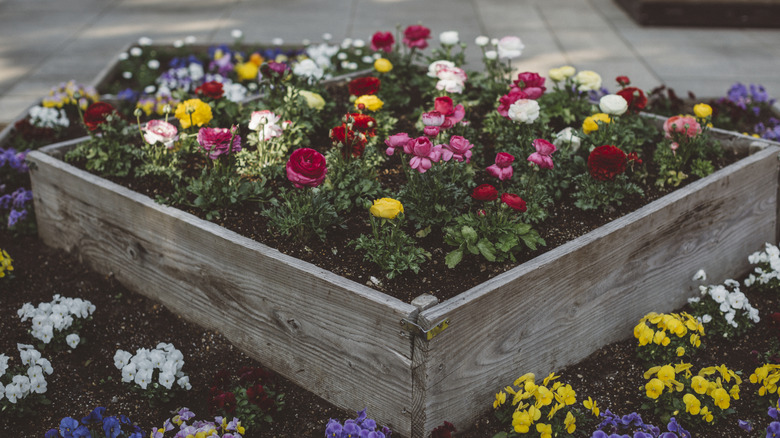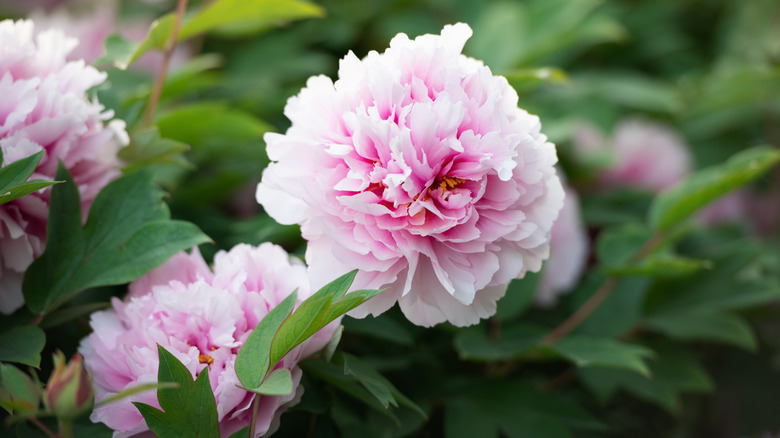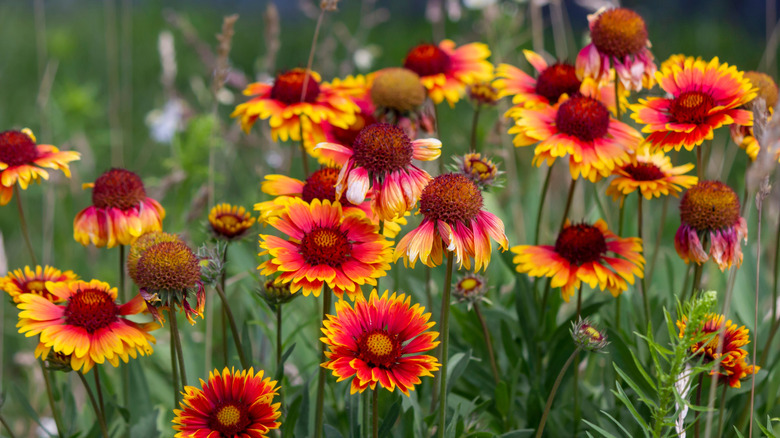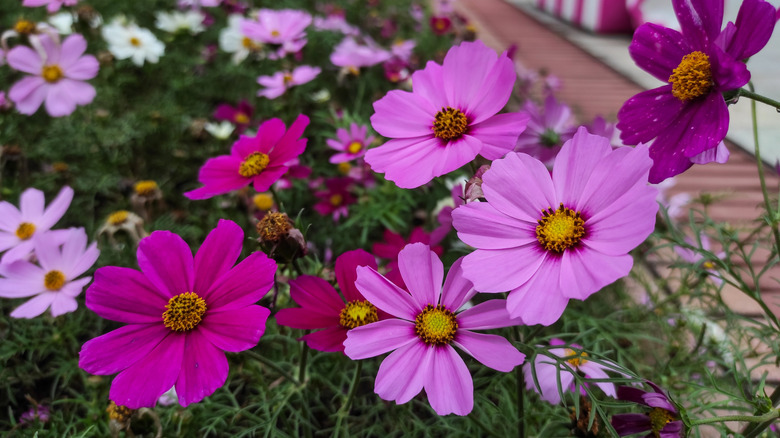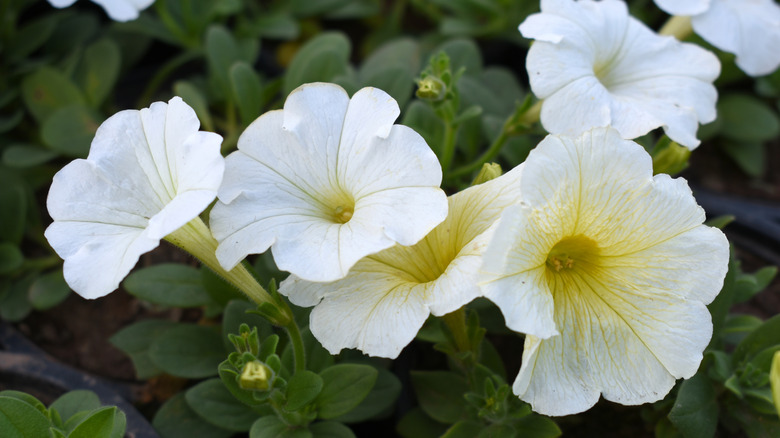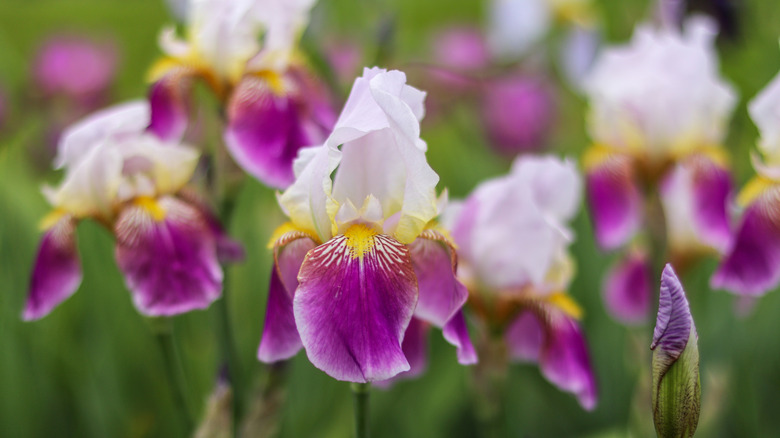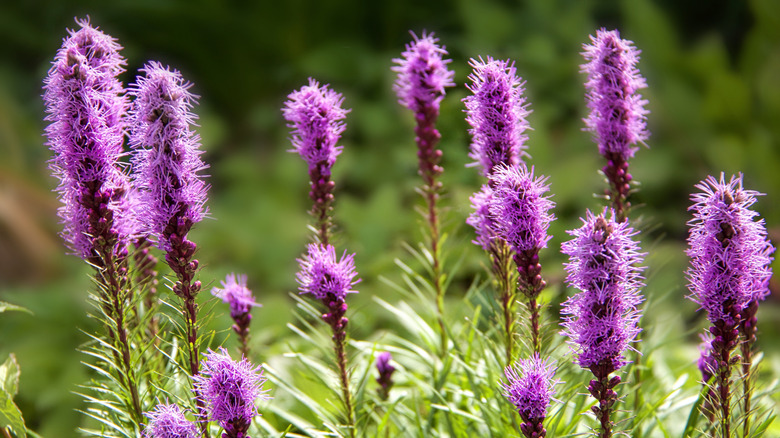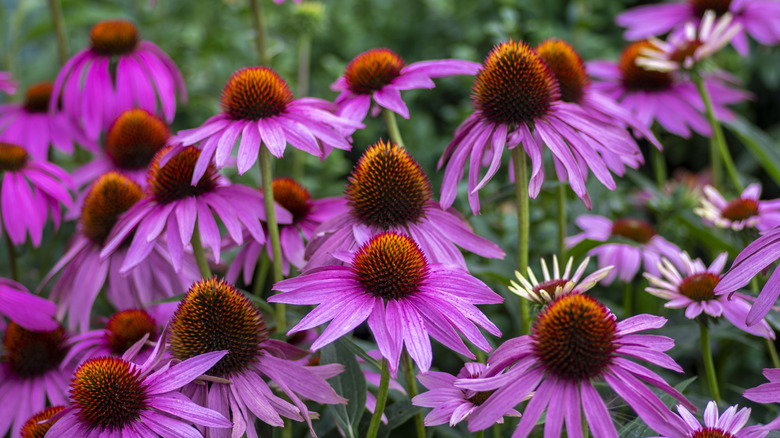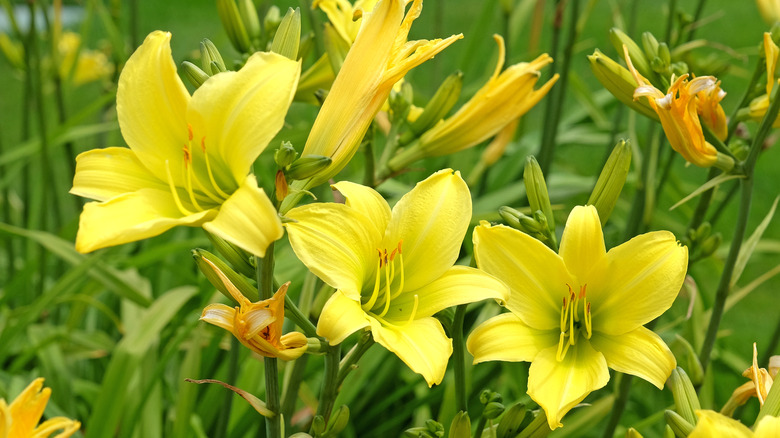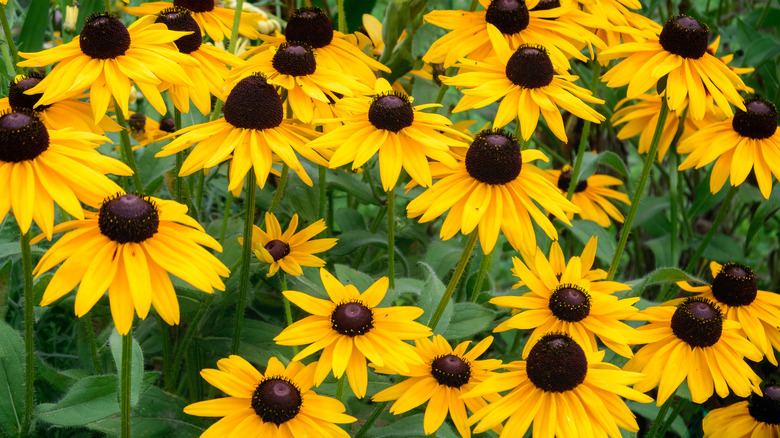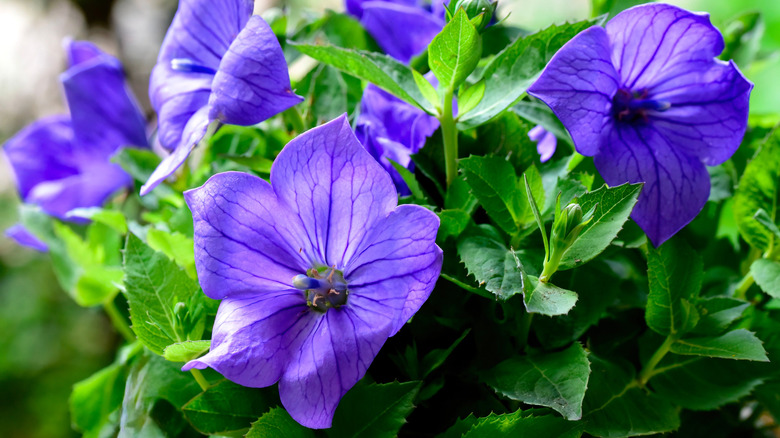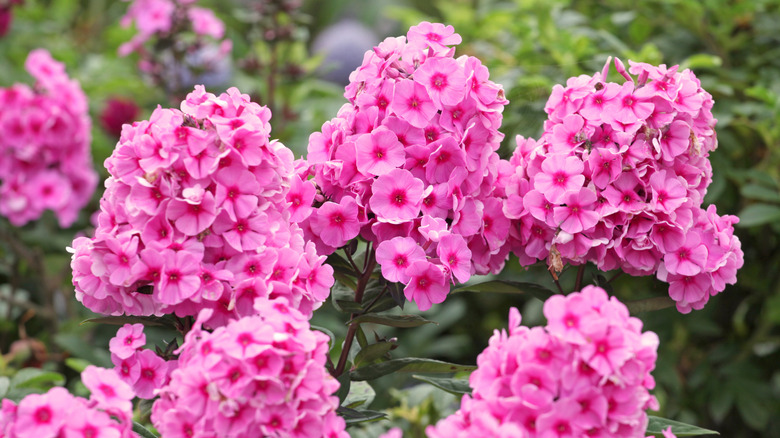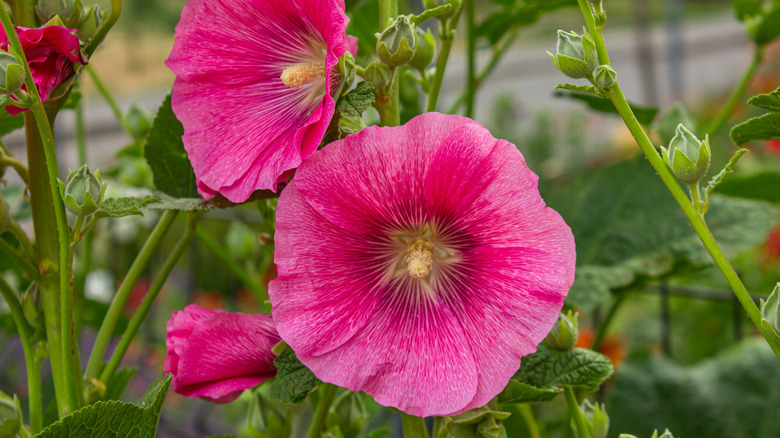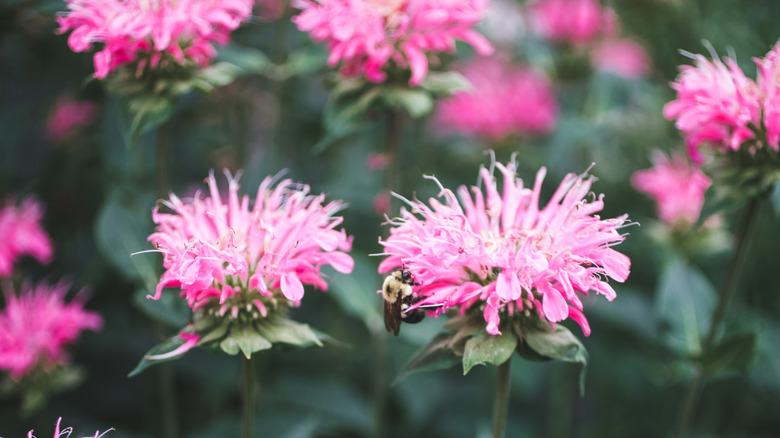15 Flowers That Will Flourish In Any Environment For An Easy-To-Grow Garden
Gardening doesn't have to mean constant weeding, watering, and worrying. If you've ever been discouraged by flowers that demand perfect conditions or wilt at the first sign of trouble, it might be time to rethink your approach. In fact, some of the most beautiful flowers are also the most self-sufficient. Whether you're planting your very first bed or looking to fill in a few gaps with something reliable, low-maintenance flowers like petunias, coneflowers, bee balm, and more can give your garden the color and charm you want without giving you any stress.
To help you get started, we've pulled together a list of garden favorites that don't mind poor soil, shrug off the heat, and won't pout if you forget to water them once in a while. Some even thrive in the kind of tough conditions that would make other plants wilt in protest. Just give them a good spot, plant them right, and let them do their thing.
Peonies
Peonies (Paeonia spp.) are beloved for their lush, oversized blooms and surprisingly low-maintenance nature. These classic perennials are a long-term investment, returning year after year with minimal fuss. Their large, fragrant flowers bloom in mid-to-late spring, showcasing soft shades of pink, white, red, and even yellow. Once the blooms fade, the peonies' foliage will eventually turns a striking red in autumn. They thrive in well-drained soil and full sunlight, performing best in USDA Hardiness Zones 5 through 7.While these flowers don't like to be moved once planted outdoors, you can grow peonies indoors with proper light and drainage.
Yarrow
For a flower that symbolizes love, yarrow (Achillea millefolium) is refreshingly low-maintenance. This tough perennial grows best in zones 3 to 9 and thrives in full sun with well-drained soil. It prefers dry, rugged conditions over extra care and doesn't need much water once settled in. In fact, too much moisture can actually hold it back. Its bright blooms attract butterflies and light up the garden — all while asking for almost nothing in return. The flat-topped yarrow blooms appear in shades of yellow, red, pink, and everything in between, rising above soft, feathery foliage.
Blanket flower
Few flowers bring as much color with so little effort as blanket flower (Gaillardia aristata). These sun-loving perennials bloom from early summer into fall, showing off fiery tones of red, orange, and yellow. They're not picky about soil, as long as it drains well, and handle heat, drought, and even cold without complaint. Don't overwater and keep the soil from getting too wet. Blanket flowers also self-seed easily, filling garden beds or borders with little intervention. These blooms thrive across zones 3 to 10 and don't mind tough conditions — an easy win for gardeners at any level.
Cosmos
It's hard to beat cosmos (Cosmos bipinnatus) if you're looking for color with zero hassle. These tall, feathery plants bloom in soft pinks, whites, and rich maroons, adding movement and lightness to any sunny garden. They grow easily from seed, tolerate poor soil, and thrive in dry, hot spots most flowers avoid. Cosmos flowers don't need fertilizer, only occasional watering, and little care. They bloom all season and attract butterflies and bees along the way. Hardy in zones 2 to 11, cosmos can be grown as annuals in most climates, returning year after year in warmer regions through self-seeding.
Petunias
Petunias are colorful crowd-pleasers that work in containers or spilling over garden beds. With varieties in every shade and shape, there's a petunia for nearly everyone. They only have one non-negotiable, which is sunlight. Petunias need at least six hours of full sun to bloom at their best. They tolerate heat well and aren't fussy about soil, as long as it drains properly. While the common garden petunia isn't considered invasive, Mexican petunia plants (Ruellia simplex) can be a problem in some areas. In parts of the southeastern U.S., it's considered invasive because it can crowd out native plants.
Bearded iris
The name might not paint a pretty picture, but bearded iris (Iris germanica) is one of the most beautiful flowers you can grow. It's bold, colorful, and doesn't ask for much in return. As long as it gets full sun and a bit of space, it's happy. Just make sure the rhizomes sit slightly above the soil. If they're buried or crowded, they'll hold back on blooming. They grow reliably in zones 3 to 9, aren't fussy about soil, and barely need watering — just plant them and let them do their thing.
Blazing star
If your garden needs something tall, tough, and fuss-free, blazing star (Liatris spicata) is worth a spot. With tall spikes that reach for the sky, it brings instant structure and late-season color to any garden. Native to North America, it grows wild in grasslands and meadows, which gives you a clue about how tough it really is. It grows well in full sun and can handle both heat and humidity. As long as the soil drains well and isn't too dry, it doesn't ask for much. You might prune it back if needed, but it's low-effort and reliable.
Purple coneflowers
Purple coneflower (Echinacea purpurea) is one of the easiest perennials to grow. It's native to the zones 3 to 9, and can handle heat, drought, and poor soil without much effort. Its daisy-like blooms feature long, colorful petals that surround a raised, dark center cone. The flowers bloom from summer through fall and attract bees, butterflies, and birds if you leave the seed heads in place. Coneflowers grow best in full sun but will tolerate light shade, as long as they get six hours of sun a day. They don't spread aggressively, but you might see new plants pop up if you skip deadheading.
Daylilies
Daylilies (Hemerocallis spp.) may only bloom for a day, but they keep the show going for weeks. Each stem holds a dozen buds or more, and mature plants send up several scapes at once, making these perennials feel like nonstop bloomers. Daylilies grow best in zones 4 to 9, handling drought with ease and needing very little maintenance. Make sure to plant them in full sun and water during dry spells. With thousands of varieties available, you can easily find one that fits your garden and keeps blooming all season.
Black-eyed Susan
Black-eyed Susan (Rudbeckia hirta) is a tough, cheerful bloomer that lights up gardens from midsummer into fall. It thrives in zones 3 to 9, growing up to 4 feet tall and standing strong through heat, drought, and even deer. It grows best in full sun and well-drained soil, whether that's clay, loam, or sand. Once planted, it quickly settles in and requires minimal upkeep. Black-eyed Susan is the kind of flower that feels right at home and makes itself useful, attracting pollinators while adding a golden touch to any garden space.
Stonecrop
Stonecrop (Sedum ternatum) is a flower that practically takes care of itself. With fleshy, green leaves and soft clusters of pale pink or white star-shaped flowers, it brings subtle texture and charm to sunny borders, rock gardens, or containers. Pollinators love it, and so do gardeners who want low-effort beauty. It grows best in full sun and well-drained soil, and handles zones 3 to 9 with ease.
Balloon flower
Balloon flower (Platycodon grandiflorus) is a charming perennial that's earned the Royal Horticultural Society's Award of Garden Merit, and a flower that wins awards should definitely earn a spot in your garden. Hardy in zones 3 to 8, balloon flower puts on a summer show with bright violet-blue blooms that burst from puffy, balloon-like buds. Its tidy stems stay upright, the blue-green foliage turns a lovely purple in fall, and it doesn't demand much care. All it needs is a soil that drains well, and a spot where the sun shines most of the day.
Phlox
Phlox adds a soft, romantic touch to any garden. It blooms in clusters of pink, red, white, or purple and thrives in rich and moist soil. For best results, plant phlox in spring after the last frost, or in fall at least a month before the first one. You can grow phlox easily in zones 2 to 9. It's easier to start with cuttings or transplants than seeds. Tuck it into borders, beds, or containers, and watch as butterflies and songbirds come fluttering in.
Hollyhocks
Hollyhocks (Alcea rosea) bring old-fashioned charm to any garden, especially when planted at the back of a flower bed where their tall stalks can really shine. Hardy in zones 3 to 8, these cottage garden classics bloom in romantic shades that pollinators like painted lady butterflies can't resist. To keep them happy, plant in a sunny spot with well-drained soil and try not to crowd them. They need at least six hours of full sun or they'll start leaning like they're tired of standing.
Bee balm
Bee balm (Monarda spp.) is a summer showstopper with shaggy blooms in pink, red, purple, and white, drawing in hummingbirds, bees, and butterflies like it's hosting a garden party. Plant it in full sun and keep the soil evenly moist. Too much shade or soggy ground can lead to powdery mildew. It spreads fast through its roots, so divide clumps every couple of years to keep them tidy. Bee balm grows best in USDA Zones 3 to 9. You can plant it in either spring or fall, but spring is the best time for dividing.
